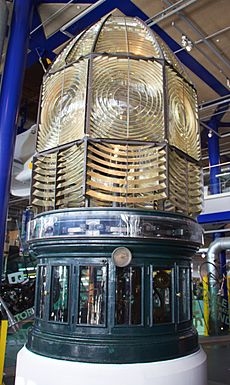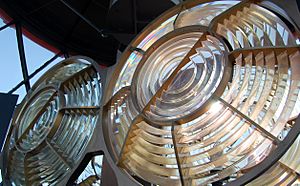Longstone Lighthouse facts for kids
| Location | Longstone Rock Farne Islands Northumberland Coast England |
|---|---|
| Coordinates | 55°38′38″N 1°36′39″W / 55.643836°N 1.610836°W |
| Year first constructed | 1826 |
| Automated | 1990 |
| Deactivated | 2015–2016 (modernization) |
| Foundation | stone and rock |
| Construction | stone tower |
| Tower shape | tapered cylindrical tower with balcony and lantern |
| Markings / pattern | red tower with horizontal central white band, red lantern |
| Height | 26 m (85 ft) |
| Focal height | 23 m (75 ft) |
| Original lens | small 3rd order catadioptric twin spectacle lens |
| Intensity | 116,000 candela |
| Range | 18 nmi (33 km) |
| Characteristic | Fl W 20s. |
Longstone Lighthouse is an important lighthouse built a long time ago in the 1800s. It stands on Longstone Rock, which is part of the Farne Islands near the coast of Northumberland, England. It was finished in 1826.
This lighthouse was first called the Outer Farne Lighthouse. It worked together with the older Inner Farne Lighthouse. Longstone Lighthouse is most famous for a shipwreck in 1838. A ship called the Forfarshire crashed, and Grace Darling helped save people. She was the lighthouse keeper's daughter.
Contents
History of Longstone Lighthouse
Early Lights on the Farne Islands
The Farne Islands have always been a dangerous place for ships. Many rocks and shallow waters made sailing tricky. For a long time, people wanted a light to warn ships. In 1673, King Charles II tried to get a lighthouse built. But the plan did not work out. Ship owners did not want to pay to keep the light working.
Later, in 1727 and 1755, more requests were made for a lighthouse. These were also turned down. Finally, in 1776, Captain John Blackett got permission. He built two beacons that burned coal. One was on Staple Island, and the other was on Inner Farne.
These first lights started working in December 1778. But the Staple Island light was badly damaged in a storm just six years later. A new one was built on Brownsman Island in 1795. This one also needed rebuilding after another storm in 1800.
Robert Darling worked as a lighthouse keeper at Staple Island. He moved to Brownsman Island in 1795. When Robert passed away in 1815, his son William took over as keeper. William was Grace Darling's father.
Building the Current Lighthouse
In 1806, a group called Trinity House looked at the islands. They wanted to build new lighthouses that used oil, which was better than coal. By 1811, they had built three new ones. Two were on Inner Farne, and one was on Brownsman.
However, the Brownsman Island Lighthouse was not in the best spot. Many ships still crashed on the rocks further out at sea. Several ships were lost in 1823 and 1824. One ship, the George and Mary, sank, and all 100 people on board were lost.
This made Trinity House decide to act. They bought the rights to the islands in 1825. Then, they quickly built a new lighthouse on one of the furthest islands, Longstone.
Longstone Lighthouse was designed by Joseph Nelson. He had also worked on the Inner Farne and Brownsman lighthouses. Building the new lighthouse was fast. The light at Longstone Lighthouse first shone on February 15, 1826. It cost about £4,771 to build.
The tower was painted red. It had a light that spun around, showing a bright flash every 30 seconds. Inside, it had twelve special lamps that made the light very strong.
William and Grace Darling's Heroism
In 1826, William Darling and his family moved to Longstone Lighthouse. William became the new lighthouse keeper. On September 7, 1838, his daughter Grace saw something terrible. A paddle steamer ship called the Forfarshire had crashed on a nearby rocky island.
Grace Darling became very famous for her part in saving the survivors. She and her father rowed out in a small boat in a terrible storm. They helped rescue people from the wrecked ship. Both Grace and her father were given silver medals for their bravery. These medals came from the Royal National Institution for the Preservation of Life from Shipwreck, which is now called the Royal National Lifeboat Institution.
Lighthouse Improvements Over Time

In 1873, the light inside Longstone Lighthouse was made better. A new special lens, called a Fresnel optic, was added. This lens helped make the light much brighter and stronger. It still flashed white every thirty seconds.
Other improvements happened around this time. In November 1876, a fog siren was added. This siren made loud blasts every two minutes to warn ships in foggy weather. Around 1890, an even more powerful siren was installed. It used compressed air to make its loud sound.
In 1895, a white band was painted around the middle of the red tower. This made the lighthouse easier to see during the day.
Modern Upgrades and Electrification
During the Second World War in 1942, the building that held the fog signal was destroyed by bombs. After the war, in 1951, a new building for the keepers was constructed. This was part of a big upgrade that started in 1946 and finished in 1952.
During this time, the lighthouse light was changed to use electricity. A new and unusual 'spectacle' shaped lens was put in. Each side of this lens had a very bright 1000-watt light bulb. It spun around by clockwork and flashed once every twenty seconds. This new light was one of the strongest on the East Coast of England.
Diesel engines were installed to create electricity for the lamp. They also made compressed air for the fog siren. A new, powerful siren was added, making a loud sound from two cone-shaped parts on a smaller tower next to the lighthouse. The electricity also powered the living areas. All these new systems started working in 1952. The old lens from 1873 was later put on display in a museum in Birmingham.
Automation of the Lighthouse
In 1990, Longstone Lighthouse became fully automated. This meant that lighthouse keepers were no longer needed to live there. Before automation, an electric fog signal had replaced the older siren.
Until 2015, the diesel generators at Longstone ran all day and night. In 2015, the lighthouse started using solar power. This greatly reduced its carbon footprint, making it more environmentally friendly. An LED light source was also put inside the main lens. The light's range was changed from 24 nautical miles to 18 nautical miles. Its brightness also changed from 645,000 candelas to 116,000 candelas. The diesel generators are now only used as a backup.
Longstone Lighthouse Today
Longstone Lighthouse is still working today. It is now watched and controlled from far away by Trinity House in Harwich, Essex. You can visit the lighthouse by boat. The Golden Gate Boat Trip Company offers tours under a special agreement with Trinity House.
See also
- List of lighthouses in England


